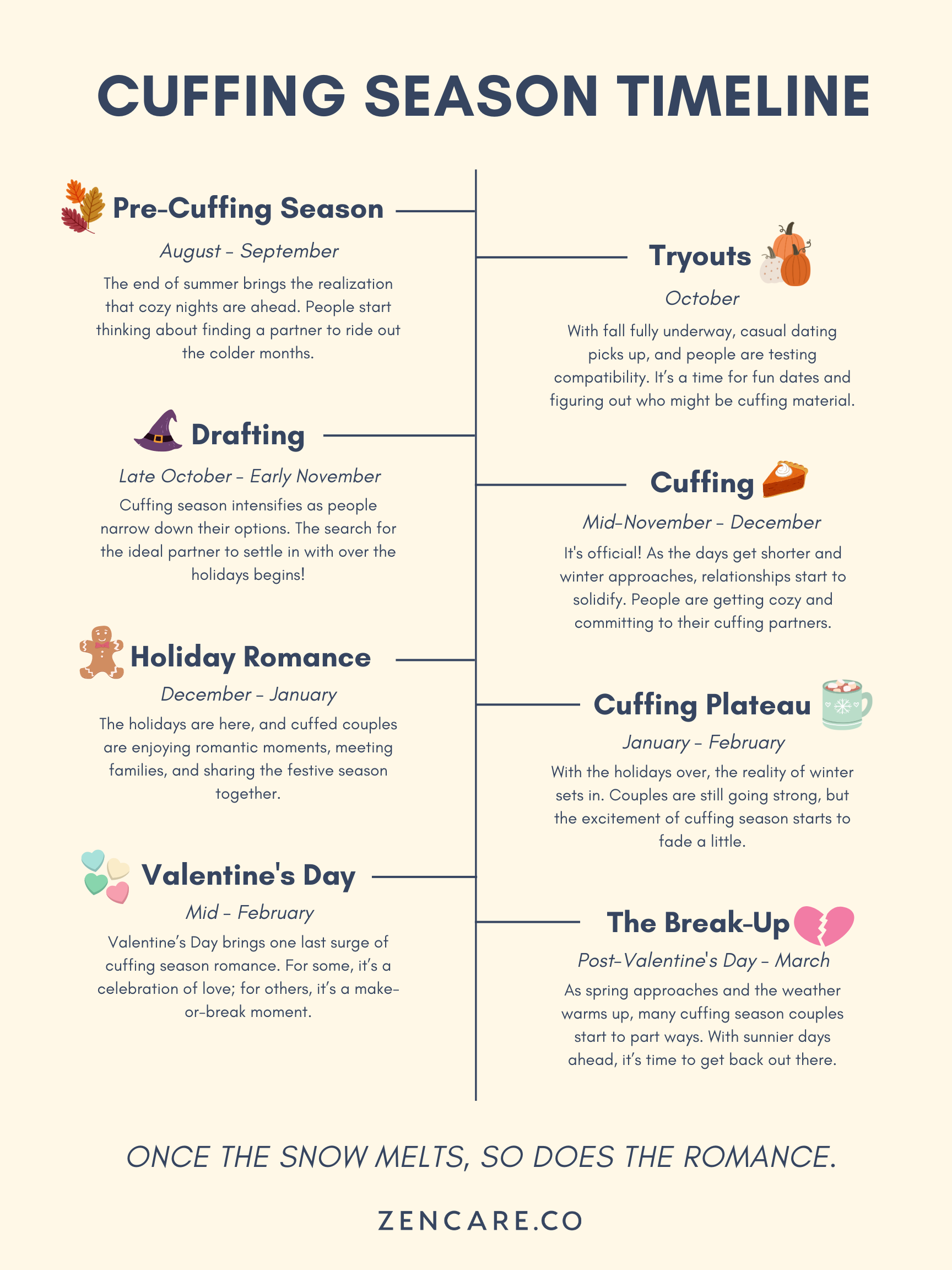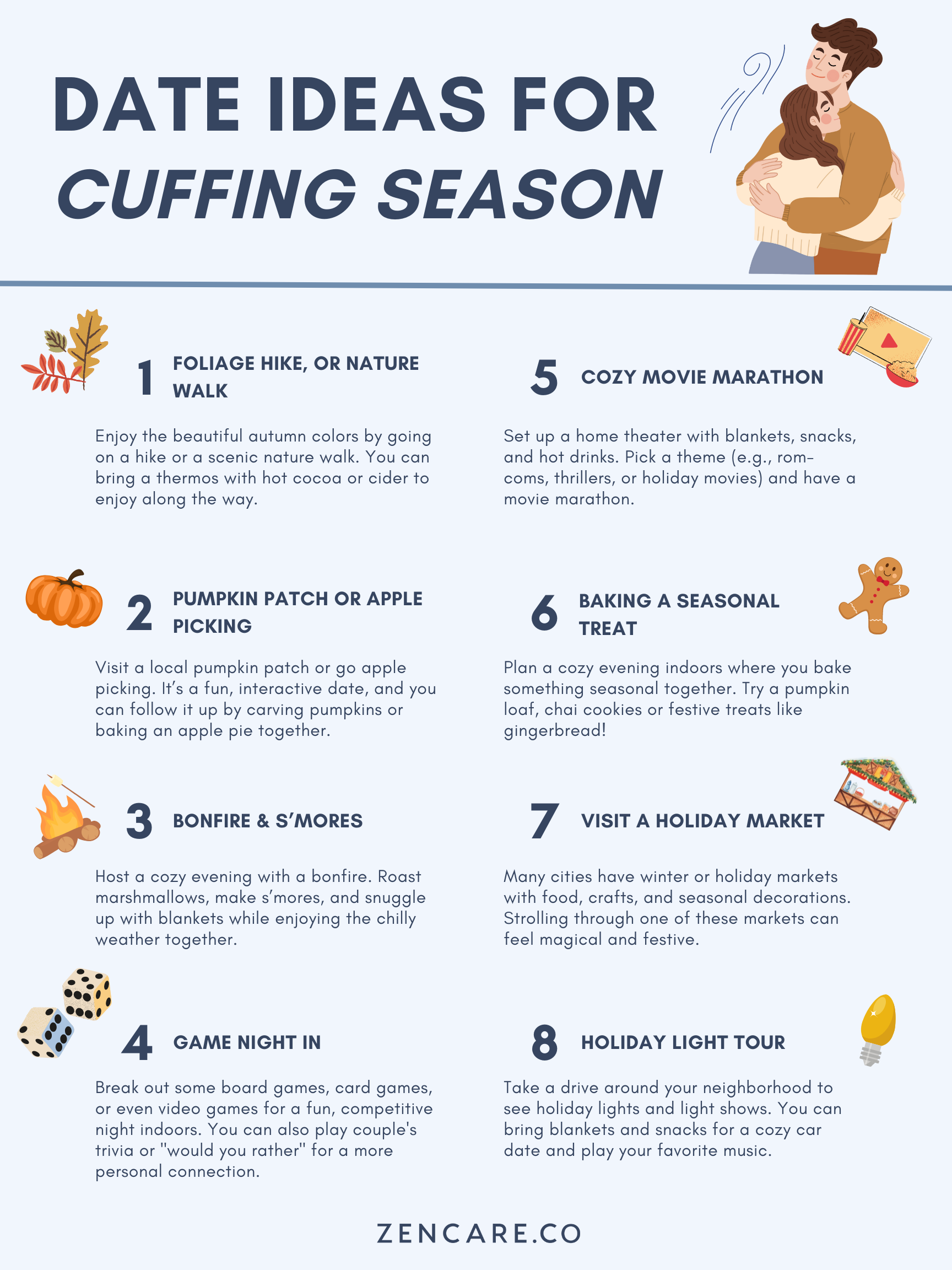Published on October 4, 2024 by Zencare Team. Reviewed by Dr. James Walton, PhD.
As the leaves fall and winter sets in, many of us notice a shift not just in the weather but in our dating lives. Known as "cuffing season," this time of year has become a buzzword, thanks to social media, but it’s more than just a trendy phrase. It reflects a real change in how single people approach relationships as the days get shorter and colder, with many seeking warmth and companionship during these months.
From cozy nights in to holiday gatherings, cuffing season speaks to our desire for human connection when the world outside turns cold. So, is cuffing season real, or is it just a clever excuse for a winter fling? Let's dive into the science behind it—because as it turns out, there's more to this dating trend than just cozy nights and cute Instagram posts.

What Is Cuffing Season?
You’ve probably seen the memes: cozy blankets, mugs of hot cocoa, and the term "cuffing season" popping up every fall. But what exactly does it mean? cuffing season refers to the time of year when single people feel a stronger urge to settle down with a partner, specifically for the colder months. It’s as if the drop in temperature sparks a biological instinct to find someone to cuddle up with until spring.
The term "cuffing" comes from the idea of being handcuffed or tied down to someone temporarily—typically starting in late fall and stretching through the winter season. Many credit rapper Fabolous for popularizing the term in his 2013 song, but the concept has existed long before that. In recent years, dating apps and social media have given it new life, with users openly seeking "cuffing partners" as soon as the first cool breeze rolls in. It’s funny and relatable, but is there actually some truth to the idea?
Why Does Cuffing Season Happen?
The Psychology Behind Cuffing Season
If you’ve ever felt an emotional shift when the weather gets colder, you’re not alone. There’s actual psychology behind why cuffing season happens, and it goes beyond just wanting someone to share a blanket with. As the days get shorter, many people experience what’s known as the "winter blues"—a milder version of Seasonal Affective Disorder (SAD). The lack of sunlight and the shorter days lower your serotonin levels, which can leave you feeling down, tired, and craving comfort.
There’s a definite shift in dating habits during the colder months. People tend to lean toward short-term relationships or deeper connections as the weather cools. Part of this is driven by the lack of social activity—once summer fades and the outdoor festivals, BBQs, and beach trips are gone, there are fewer distractions. The colder weather leaves people looking for new ways to spend time, and finding a partner for those cozy nights becomes more appealing.
This time of year naturally heightens the need for companionship. In other words, when the temperatures drop and we spend more time indoors, the desire for closeness—both physical and emotional—grows. It’s not just about surviving the winter chill but feeling connected to someone when the outside world feels distant and cold.
“During the colder months, it's natural for us to desire deeper connections, especially when the shorter days and extra time indoors can leave us feeling a bit isolated or lonely. It's so important to listen to your internal needs and find ways to meet them that feel fulfilling, both with the people around you and on your own,” says Dr. James Walton, PhD.
Typically, cuffing season relationships start in late fall or early winter and continue through the colder months. But as spring approaches and social opportunities increase, these relationships often dissolve. The warmer months bring a sense of freedom and renewal, leading people to move on from their seasonal partner and, in many cases, return to single life. There’s even an unspoken expiration date for many cuffing season relationships—once the snow melts, so does the romance.
Social Influences on Cuffing Season
While biology plays a part, social pressures can intensify the pull of cuffing season. The holiday season is filled with moments that make being single a little more noticeable. From holiday parties to family gatherings, there’s often an unspoken pressure to bring a partner. Family members ask about your relationship status, and you might find yourself surrounded by couples at holiday events. Throw in the looming presence of Valentine’s Day, and it’s no wonder people feel an urgency to couple up, even if just for the season.
The winter months also lend themselves to more intimate indoor activities. Think about it—whether it’s binge-watching holiday movies or curling up with a good book, the colder weather invites us to stay inside and get cozy. Naturally, the idea of doing that with someone else becomes more appealing.
Social media plays a huge role in cuffing season, too. Platforms like Instagram and TikTok are filled with posts about finding a "cuddle buddy" or searching for the perfect partner to spend the winter with. It’s easy to feel like you should be in a relationship when your feed is flooded with romantic holiday moments, love songs, and cozy couple photos.
This pressure can be especially tough for single people who might already feel out of place during the holiday season. Seeing couples at every turn—whether it’s at family gatherings, holiday parties, or even just on TV—can create a sense of urgency to find a partner, even if it’s just for the winter.
Is Cuffing Season Harmful or Helpful?
Experts have mixed opinions on cuffing season. Family therapists and relationship experts often debate whether it’s a harmless dating trend or something that can lead to unnecessary hurt feelings. On the one hand, finding a partner for a specific period of time can provide much-needed comfort and closeness. On the other hand, temporary relationships can blur lines and lead to confusion if both people aren’t clear about their intentions.
Dr. James Walton shares, “I met my future spouse during cuffing season. Two years later we were married and now have been together for 10 years. Finding the right relationship is a numbers game, so I support any reason for people to mix, meet and connect even if it is likely to be a temporary experience. You never know!”
The reality is, cuffing season isn’t inherently bad or good—it all depends on how you approach it. It’s crucial to set clear boundaries and maintain open communication to avoid misunderstandings. Whether you’re in it for a quick fling or hoping for something deeper, being honest with yourself and your partner is key.
Cuffing Season vs. Situationships: What's the Difference?
Now, let’s get real—do cuffing season relationships last? The answer isn’t black and white. Some relationships formed during this time are built on comfort rather than long-term compatibility. However, that doesn’t mean they’re all doomed to fail.
Both cuffing season relationships and situationships exist in a gray area between casual flings and committed partnerships, but there are key differences in their dynamics and timelines. Understanding these distinctions can help you identify which type of relationship you’re in and whether it aligns with your long-term goals.
Cuffing Season Relationships
- Time-Bound: Cuffing season relationships typically emerge in late fall and extend through the winter months, driven by the desire for warmth and companionship during colder weather. As the name suggests, these relationships often have an unspoken expiration date—usually around spring when social opportunities increase.
- Seasonal Influence: These relationships are influenced by the colder months and the holiday season, where people may feel pressure to couple up for holiday events, family gatherings, and Valentine’s Day. The physical coldness of the season often leads to a focus on physical intimacy over emotional depth.
- Purpose: The main goal is comfort and closeness to get through the winter blues, but these relationships may not extend beyond the seasonal need for companionship. Emotional connection is often secondary to the convenience of having someone during cold nights.
Situationships
- No Set Timeline: Situationships don’t follow a seasonal pattern; they can occur at any time of the year and typically have no defined endpoint. Unlike cuffing season relationships, there’s no clear signal (like the arrival of spring) that the relationship might end.
- Ambiguity: Situationships are marked by uncertainty and a lack of commitment. Both parties might engage in regular interactions, including physical intimacy, without defining the relationship or setting clear expectations for the future. This ambiguity often leads to emotional confusion or mismatched intentions.
- Lack of Definition: In situationships, the relationship status is often left undefined. There may be frequent interaction, but discussions about future plans or exclusivity are avoided. Unlike cuffing season, where the intention is usually to get through a specific period, situationships can drag on for months or even years without progressing toward a more serious commitment.
Red Flags in Cuffing Season Relationships
- Avoiding future conversations: If your partner evades discussions about what will happen after the winter season or refuses to talk about future plans, it’s a sign they might only be interested in a temporary connection.
- Reluctance to define the relationship: In both cuffing season relationships and situationships, a clear red flag is when your partner avoids defining the relationship. Phrases like "Let’s not label it" or "We’re just having fun" often signal their unwillingness to commit.
- Physical intimacy over emotional connection: If the relationship feels like it’s centered solely around physical intimacy with little effort to build emotional depth, this can be a red flag that your partner isn’t invested in a long-term connection.
- Ignoring boundaries: If one partner wants to keep things casual while the other seeks emotional connection, the lack of respect for boundaries can lead to misunderstandings and emotional strain.
- Inconsistent communication: A partner who is available one moment and disappears the next without explanation is a major red flag. Inconsistent behavior often points to a lack of commitment or priority.
- Limited social integration: If your partner avoids introducing you to their friends or family, or if they’re reluctant to meet yours, it may signal that they’re not seeing the relationship as something serious or long-term.
- Avoiding emotional vulnerability: If your partner constantly avoids discussing their feelings or emotional needs, it could indicate they’re emotionally unavailable, leaving the relationship stuck in a superficial phase.
- Prioritizing convenience: If the relationship only happens on your partner’s terms—when it’s convenient for them—without considering your needs or schedule, it’s a red flag that they’re not making an effort to invest in the relationship.
- No progress over time: In situationships, if the relationship doesn’t evolve after months of dating, it’s a red flag that your partner may not be interested in moving things forward or exploring a deeper connection.
- Frequent excuses for emotional distance: Your partner may frequently use excuses like “I’m not ready for something serious” or “I’m not good at relationships” to justify their emotional detachment. This could indicate they’re not open to a committed relationship.
The best way to avoid heartbreak? Be upfront with your partner about your intentions and expectations. If you’re both on the same page, cuffing season can be a fun, fulfilling time. But if one person is expecting more than the other, it’s important to have an honest conversation about your future plans.
How to Enjoy Cuffing Season in a Healthy Way
- Communicate clearly: Be upfront about what you’re looking for. Whether you're seeking a cuffing season relationship for the colder months or something more long-term, it's crucial to set expectations early. Honest conversations about your future plans can prevent confusion and hurt feelings later on.
- Set healthy boundaries: Ensure that both you and your partner are aligned in terms of emotional and physical boundaries. Discuss what you’re comfortable with, how often you want to spend time together, and whether this is a short-term relationship or one that could extend beyond the winter season.
- Take note of red flags: Keep an eye out for behaviors like avoiding relationship status talks, inconsistent communication, or reluctance to introduce you to friends or family. If you spot any red flags, don’t ignore them—address them with your partner to clarify where you both stand.
- Don’t rush emotional connection: While it’s tempting to get cozy quickly, remember that genuine emotional connection takes time. Resist the urge to fast-track intimacy, and instead focus on building a deeper bond through shared experiences and meaningful conversations.
- Be mindful of winter blues: The colder months and shorter days can trigger feelings of loneliness or winter blues, driving people to seek companionship out of convenience. Recognize whether your desire for a cuffing season partner is based on genuine interest or just a response to the cold weather.
- Enjoy the moment: Whether you’re single or in a seasonal relationship, embrace the holiday season by focusing on the joy it brings. Spend time with good friends, engage in indoor activities like holiday movie nights, and celebrate the winter holidays without stressing too much about your relationship status.
- Check in regularly: Throughout cuffing season, have regular check-ins with your partner to ensure you’re still on the same page. This prevents assumptions and keeps the lines of communication open, especially as the relationship evolves or the seasonal relationship begins to shift.
- Keep your social life active: Don’t lose touch with friends or hobbies just because you’ve found a cuffing season partner. Maintaining a balance between your romantic relationship and your social life will help keep things in perspective and prevent you from becoming too reliant on one person for emotional support.
- Don’t settle: Even during cuffing season, don’t settle for a relationship that doesn’t meet your emotional needs. If you’re hoping for a more serious relationship, and your partner isn’t reciprocating, it’s okay to move on rather than prolong something that isn’t fulfilling.
- Manage expectations: As spring approaches, understand that cuffing season relationships often have an expiration date. Be prepared for the possibility that the relationship may not transition into a long-term commitment, and set your expectations accordingly to avoid disappointment.
By following these tips, you can navigate cuffing season confidently, ensuring that your relationship expectations are clear and that you enjoy the season for what it is, without unnecessary stress or confusion.
The Lasting Impact of Cuffing Season
At the end of the day, cuffing season is real, but it doesn’t have to be complicated. It’s a natural response to the colder months and the desire for connection, comfort, and warmth. Whether you’re looking for a temporary partner or hoping to find a long-term partner, being mindful of your emotions and communicating openly can help you navigate this season with confidence.
So, the next time the temperature drops, and you feel the urge to "cuff," remember: cuffing season can be what you make of it. Whether it’s a short-term fling or the start of something deeper, the key is to embrace it with self-awareness and care. And even if the relationship fades as the snow melts, it’s still an opportunity to learn about yourself, your needs, and what you truly want from your romantic life. After all, spring is just around the corner—and with it, new opportunities for love, growth, and connection.If cuffing season or other relationship challenges are weighing on you, talking to a licensed therapist can help. Zencare connects you with experienced mental health professionals who can offer guidance on navigating relationships, mental health, and personal growth. Explore your options at Zencare and find the right therapist to support your journey today.


